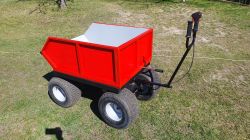marweg1967 wrote:One channel for about 4 k PLN? Well, Lord, it's almost high-end. Something just in time for another block to the resurrected Unitra.
By the way, I wonder how it would look during blind listening compared to the work of the author of the topic.
Unfortunately, the right OP-AMPs are expensive :c
Without offending other designs of the mentioned author, it seems to me that such a device would work quite well. Think about it - is it better to use single power transistors with medium parameters, but with adequate power, or to use a bucket of small transistors in parallel? Is it better to put one large 10000uF capacitor somewhere on the edge of the board, or instead have a thousand 10uF ceramic SMDs, one per op-amp?
Is it better to run currents on narrow paths with high inductance, or use copper fields with 20 PCBs with power elements as paths?
The author's design is stupid, incredibly impractical when it comes to the approach to building an amplifier. This is the extreme of all the principles of building this type of system. But I want one too. I'm at the design stage




